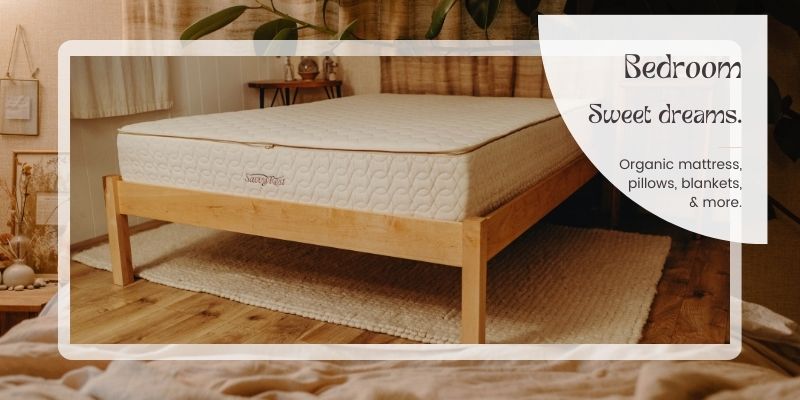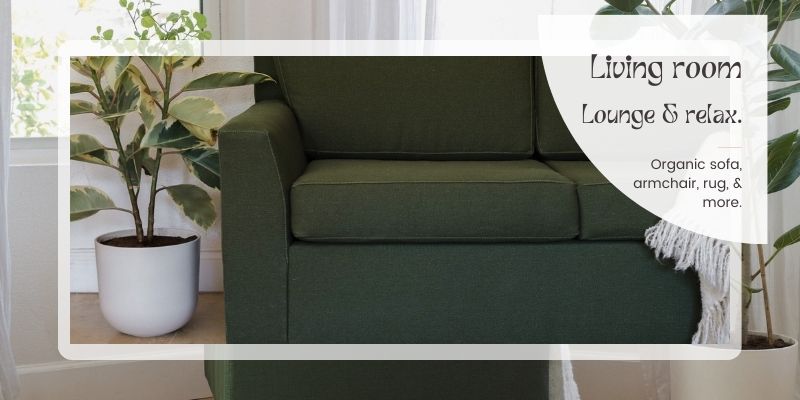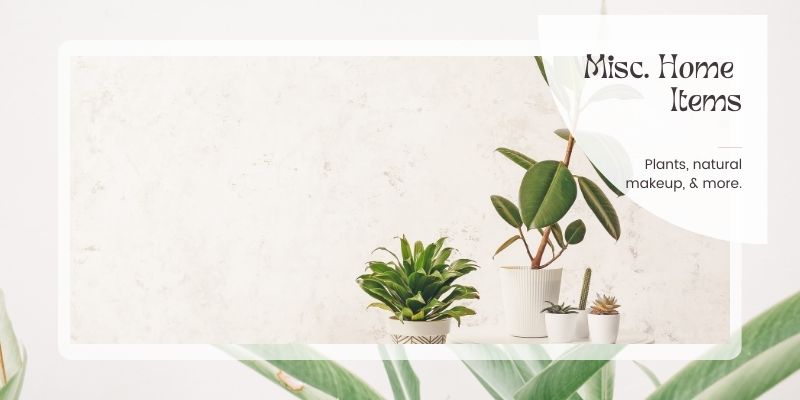You’ve been doing your research and have discovered that products you thought were safe, aren’t. You are beginning to ask questions about material purity, manufacturing practices, harmful chemicals, and more. But all those specific questions can sometimes bring about the overwhelming ultimate question: Where do I start?
If you are new to non-toxic living (or low tox living, which is the more realistic term) and need help determining what to prioritize when switching over to a more sustainable and healthy lifestyle, keep reading.
1. Make a Low Tox Wish List
Sit down and write a list of products you’d like to swap out for natural alternatives–both large and smaller purchases. It may be even beneficial to organize the list by most to least costly, or perhaps you would prefer to organize your list based on rooms in the house. It doesn’t matter as long as it is clear to you!
Feel free to also include things that don’t cost any money, such as going outside and practicing grounding, or making a commitment to cook more meals at home rather than relying on fast food.
2. Figure out your Budget
Now, if you have enough money to spend thousands at a time, that’s amazing! But that’s not the reality for most households. So, it’s time to budget.
You can either pinpoint a yearly budget, or you can start small and go month by month. What can you afford to invest in this month? Or does this month need to be low spend and instead focused on the free or low cost options?
Whatever the case, make sure that you have a plan!
3. Start Shopping: Natural Products for the Home
Once you know your budget, you can start figuring out what you want to focus on first. Here is your ultimate guide to eco-friendly, sustainable products that will positively benefit your health, comfort, and home environment.
It’s time to minimize toxic off-gassing by saying no to products with VOCs, formaldehyde, chemical flame retardants, synthetic materials, fragrances, and more. Don’t worry–there are PLENTY of safer alternatives.
Enjoy this curated list…

BEDROOM
Serenity Organic Mattress by Savvy Rest
Why an organic mattress? We spend a third of our lives sleeping, which means we breathe in what our mattress is off-gassing. Avoid synthetic foams (memory foam and polyurethane foam) and instead opt for a natural latex mattress, preferably one that is GOTS-certified organic, like The Serenity.
Again, what we sleep on matters, especially what our face is coming into contact with every night. If you have the budget, these natural Talalay latex pillows are made using Cradle to Cradle GOLD-certified latex and covered in knit organic cotton. If you are on a budget, we recommend shredded latex pillows instead, which still offer excellent comfort and support but at a lower price.
Avoid furniture treated with harsh stains that contain VOCs, formaldehyde, and other harmful chemicals. Opt for sustainable wood that is either unfinished or only stained with a zero-VOC finish. We love The Afton for a minimalistic look, or The Esmont for a timeless headboard.
Conventional sheets can contain pesticides, bleach, and toxic dyes that are coming into contact with your skin. GOTS-certified organic cotton sheets are the way to go when swapping out your bedding for a more natural option. We love these sheets because they are soft, minimalistic, and excellent quality.
Avoid harmful chemicals and toxic dyes with organic cotton. We love the herringbone weave of this cozy organic blanket.
Instead of gravitating towards synthetic materials such as polyester, choose a duvet insert filled with temperature-regulating wool. This duvet insert is filled with natural, domestically-sourced wool that keeps you cool in the summer but warm in the winter. It is then covered in organic cotton free from pesticides.
Essential Oil Diffuser
While you can add an essential oil diffuser anywhere in your home, there’s something especially relaxing about keeping one in your bedroom. Lavender and bergamot essential oils are excellent for relaxation and promoting restful sleep. We love the selection of essential oil diffusers at Mountain Rose Herbs when curating your non-toxic bedroom.
Salt Lamp
Salt lamps help purify the air, and they are also just so beautiful and soothing to look at. We love the selection of Himalayan Salt Lamps at Himalayan Trading Co.
Low-VOC Carpet
This is definitely more of an investment but traditional carpet is typically made of synthetic materials that can offgas nasty chemicals into your bedroom air environment. To reduce toxins in your bedroom, choose a GreenGuard GOLD certified carpet made of wool, jute, or cotton. There are plenty of hypoallergenic carpets available if that is an important detail to you as well. Check out this helpful guide.

LIVING ROOM
Don’t lounge on synthetic fabrics treated with questionable dyes and lurking with PFAS. The Centers for Disease Control and Prevention reported that PFAS were found in the blood of 97% of Americans. This is staggering and even more reason to work towards introducing safer products into your home. Avoid toxic glues, chemically-treated upholstery, particleboard, and harsh stains. Opt for organic furniture made using natural materials such as organic cotton, natural latex, sustainably-sourced wood, and organic wool batting. We love the Verona sofa.
Look for upholstered chairs made with fabrics such as organic cotton or organic hemp. The Verona armchair comes in many different organic fabrics, includes zero-VOC finishes for the maple wooden feet, and even has two different arm heights available.
Some coffee tables are made using engineered wood which can contain formaldehyde, a human carcinogen. The International Agency for Research on Cancer has concluded that exposure to formaldehyde can indeed cause cancer, particularly leukemia and cancers related to the naval cavity. We recommend choosing furniture that is crafted with natural, sustainably-sourced wood and is either untreated or simply stained with zero-VOC finishes. If you cannot afford brand new natural furniture, you can look into antique furniture instead which was not produced with some of the harsh chemicals found in modern day furniture manufacturing.
Air Purifier
Clean up your home air environment by filtering viruses, dust, pet dander, and other allergens through an air purifier. You should ideally have an air purifier in your living room AND bedroom since you spend the most time in those two rooms. Air purifiers come in different sizes so make sure you know the square footage of your space to determine which air purifier to purchase. While there are a ton of options out there, Homedics is a reliable brand.
Non-Toxic Rug
An area rug is a statement piece in your living room, but it shouldn’t make a statement of toxic chemicals. Thankfully there are eco-friendly, natural rugs that look beautiful and won’t negatively impact your home air environment. Here are some fantastic options when shopping for a rug.

KITCHEN
Cast Iron Skillet
While using a non-stick pan is very tempting, a cast iron skillet is one of the most low tox options at your disposal when trying to avoid PFAS. You’ll fall in love since these pans do an excellent job of retaining heat, are super easy to clean, and will stand the test of time. You can easily get one second hand as well if you’re on a budget! Learn more about other non-toxic cookware options.
Silicone Sandwich Bags
Ditch plastic sandwich bags and instead switch to silicone bags that can be reused. This is a durable and eco-friendly option without phthalates or BPA. You can find these at grocery stores, Target, Walmart, and just about anywhere where food storage containers are sold.
Glass Food Storage Containers
Stop heating your food in plastic! Instead heat and/or store your food in glass containers. You can even use certain glass containers in the freezer, just make sure to buy a container specifically designed for this.
Non-Toxic Cooking Utensils
Our spatulas, spoons, knives, and other cooking utensils matter since these tools come into direct contact with heat as we prepare our food. Avoid PVCs and phthalates by opting for BPA-free silicone or stainless steel. Here are some safe options.

BATHROOM
Natural Shampoo & Conditioner
Finding a low tox shampoo is actually easier than you think! There is definitely more variety online, but retailers such as Whole Foods do have options in-store. Our current favorite shampoos and conditioners are from Innersense. They even have a store locator if you wish to check out their products in person.
Bamboo Toothbrush
Say no to plastic toothbrushes that end up in landfills and never break down. Bamboo toothbrushes are a much more sustainable option that is still effective.
Hand Soap
We are constantly washing our hands, so it’s important to think about what we are using. Sodium lauryl sulfate (SLS) can irritate skin, and all sorts of fragrance is added to conventional soap filled with chemicals we aren’t even given a proper list of (all it needs to say on a label is “fragrance”). Here are some brands to consider: Branch Basics, Kosmatology, and Mama Suds.
Microbiome-Friendly Body Wash
Don’t try out your skin with harsh ingredients that strip your body of its natural oils. Instead, feed your skin with microbiome friendly, non-toxic body wash, like Aleavia. Cleanse the body with coconut oil, acadian sea kelp, dead sea salt, and aloe vera.
Organic Cotton Towels
Look for towels that are made of organic cotton and are GOTS-certified. Brands such as Under the Canopy and Coyuchi have high quality options.

MISC. LOW TOX HOME PRODUCTS
Non-Toxic Cleaning Products
We use and love Branch Basics because it is fragrance free, biodegradable, and made with natural ingredients like organic chamomile and baking soda. This concentrate can be used for all your cleaning needs (all-purpose spray, bathroom, glass, hand soap, and even laundry detergent). Learn more about how it works.
Laundry Detergent
We all need to clean our clothes, but so many of the detergents you see at the grocery store are filled with harmful fragrances and chemicals that can lead to irritated skin and allergic reactions. If you are trying to find a low tox detergent that works well, here are some brands to consider: Branch Basics, Molly’s Suds, and Zuma Nutrition. You can also read this natural laundry detergent guide.
Low Tox Makeup
Our skin is our largest organ, so what we put on our face matters. Ditch foundation made of ingredients you can’t pronounce. Instead, choose products that are packed with natural, hydrating ingredients that are safe for even the most sensitive skin. Some brands to check out: ILIA, RMS Beauty, Tower 28, and Kosas. You can find them all at Sephora.
Plants
Introducing plants into your home is such a low-cost way to make a positive impact. Did you know aloe vera is an excellent plant at purifying air? If you can’t afford an air purifier at the moment, the next best thing is to get some plant friends and to also make sure you are opening the windows for fresh air every so often.
Are you ready?
It’s time for you to begin your low tox living journey. We hope this list of sustainable products has helped you feel confident in where you’d like to start. Good luck!
